I'm looking to split number on image. My main problem is that the number may touch each other. so all technique with OpenCV contour found online doesn't work.
Here the steps i've done so far. It's working well with image that have number well separated, but not with number touching each other. One of the image i try to solve:

I'm trying to do that as part of the preprocessing step so i can after that use the number in my MNIST model.
My actual code:
import cv2
import numpy as np
# 3 - detect and extract ROI's
#image = cv2.imread('imgs/01.jpg')
#image = cv2.imread('imgs/03.jpg')
image = cv2.imread('imgs/01_tresh_210.jpg')
#cv2.imshow('i', image)
#cv2.waitKey(0)
# grayscale
gray = cv2.cvtColor(image, cv2.COLOR_BGR2GRAY)
cv2.imshow('gray', gray)
cv2.waitKey(0)
# binary
ret, thresh = cv2.threshold(gray, 127, 255, cv2.THRESH_BINARY_INV)
cv2.imshow('thresh', thresh)
cv2.waitKey(0)
# dilation
kernel = np.ones((10, 1), np.uint8) # values set for this image only - need to change for different images
img_dilation = cv2.dilate(thresh, kernel, iterations=1)
cv2.imshow('dilated', img_dilation)
cv2.waitKey(0)
# find contours
im2, ctrs, hier = cv2.findContours(img_dilation.copy(), cv2.RETR_EXTERNAL, cv2.CHAIN_APPROX_SIMPLE)
# sort contours
sorted_ctrs = sorted(ctrs, key=lambda ctr: cv2.boundingRect(ctr)[0])
for i, ctr in enumerate(sorted_ctrs):
# Get bounding box
x, y, w, h = cv2.boundingRect(ctr)
# Getting ROI
roi = image[y:y + h, x:x + w]
# show ROI
#cv2.imshow('segment no:'+str(i),roi)
cv2.imwrite('imgs\\roi\\{}.png'.format(i), roi)
cv2.rectangle(image, (x, y), (x + w, y + h), (0, 0, 0), 1)
#cv2.waitKey(0)
# save only the ROI's which contain a valid information
if h > 20 and w > 75:
cv2.imwrite('roi\\{}.png'.format(i), roi)
cv2.imshow('marked areas', image)
cv2.waitKey(0)